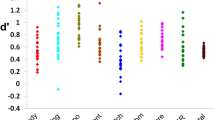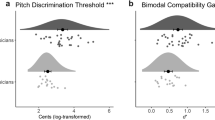Abstract
This work was conducted to study the plasticity of superior (SCP) and middle (MCP) cerebellar peduncles in musicians. The cerebellum is well known to support several musically relevant motor, sensory and cognitive functions. Previous studies reported increased cerebellar volume and grey matter (GM) density in musicians. Here, we report on plasticity of white matter (WM) of the cerebellum. Our cohort included 10/10 gender and handedness-matched musicians and controls. Using diffusion tensor imaging, fibre tractography of SCP and MCP was performed. The fractional anisotropy (FA), number of streamlines and volume of streamlines of SCP/MCP were compared between groups. Automatic measurements of GM and WM volumes of the right/left cerebellar hemispheres were also compared. Musicians have significantly increased right SCP volume (p = 0.02) and number of streamlines (p = 0.001), right MCP volume (p = 0.004) and total WM volume of the right cerebellum (p = 0.003). There were no significant differences in right MCP number of streamlines, left SCP/MCP volume and number of streamlines, SCP/MCP FA values, GM volume of the right cerebellum and GM/WM volumes of the left cerebellum. We propose that increased volume and number of streamlines of the right cerebellar peduncles represent use-dependent structural adaptation to increased sensorimotor and cognitive functional demands on the musician’s cerebellum.







Similar content being viewed by others
References
Munte TF, Altenmuller E, Jancke L. The musician’s brain as a model of neuroplasticity. Nat Rev Neurosci. 2002;3(6):473–8.
Watanabe D, Savion-Lemieux T, Penhune VB. The effect of early musical training on adult motor performance: evidence for a sensitive period in motor learning. Exp Brain Res. 2007;176(2):332–40.
Abdul-Kareem IA et al. Increased gray matter volume of left pars opercularis in male orchestral musicians correlate positively with years of musical performance. J Magn Reson Imaging. 2011;33(1):24–32.
Sluming V et al. Voxel-based morphometry reveals increased gray matter density in Broca’s area in male symphony orchestra musicians. Neuroimage. 2002;17(3):1613–22.
Schneider P et al. Structural, functional, and perceptual differences in Heschl’s gyrus and musical instrument preference. Ann NY Acad Sci. 2005;1060:387–94.
Andersen BB, Korbo L, Pakkenberg B. A quantitative study of the human cerebellum with unbiased stereological techniques. J Comp Neurol. 1992;326(4):549–60.
Williams PL et al., editors. Gray’s anatomy. 38th ed. London: Churchill Livingstone; 1995.
Snell RS. Clinical neuroanatomy for medical students. 5th ed. Philadelphia: Lippincott Williams & Wilkins; 2001.
Glickstein M, May 3rd JG, Mercier BE. Corticopontine projection in the macaque: the distribution of labelled cortical cells after large injections of horseradish peroxidase in the pontine nuclei. J Comp Neurol. 1985;235(3):343–59.
Glickstein M, Doron K. Cerebellum: connections and functions. Cerebellum. 2008;7(4):589–94.
Middleton FA, Strick PL. Cerebellar projections to the prefrontal cortex of the primate. J Neurosci. 2001;21(2):700–12.
Gao JH et al. Cerebellum implicated in sensory acquisition and discrimination rather than motor control. Science. 1996;272(5261):545–7.
Kim SG, Ugurbil K, Strick PL. Activation of a cerebellar output nucleus during cognitive processing. Science. 1994;265(5174):949–51.
Doyon J et al. Experience-dependent changes in cerebellar contributions to motor sequence learning. Proc Natl Acad Sci USA. 2002;99(2):1017–22.
Parsons LM et al. Lateral cerebellar hemispheres actively support sensory acquisition and discrimination rather than motor control. Learn Mem. 1997;4(1):49–62.
Matsumura M et al. Role of the cerebellum in implicit motor skill learning: a PET study. Brain Res Bull. 2004;63(6):471–83.
Stoodley CJ, Valera EM, Schmahmann JD. An fMRI study of intra-individual functional topography in the human cerebellum. Behav Neurol. 2010;23(1–2):65–79.
Paradiso S et al. Cerebellar size and cognition: correlations with IQ, verbal memory and motor dexterity. Neuropsychiatry Neuropsychol Behav Neurol. 1997;10(1):1–8.
Hutchinson S et al. Cerebellar volume of musicians. Cereb Cortex. 2003;13(9):943–9.
Schlaug G, Lee LHL, Thangaraj V. Macrostructural adaptation of the cerebellum in musicians. Soc Neurosci. 1998;24:842–7.
Gaser C, Schlaug G. Brain structures differ between musicians and non-musicians. J Neurosci. 2003;23(27):9240–5.
Ashburner J, Friston KJ. Voxel-based morphometry—the methods. Neuroimage. 2000;11(6 Pt 1):805–21.
Della Nave R et al. Brain white matter tracts degeneration in Friedreich ataxia. An in vivo MRI study using tract-based spatial statistics and voxel-based morphometry. Neuroimage. 2008;40(1):19–25.
Han Y et al. Gray matter density and white matter integrity in pianists’ brain: a combined structural and diffusion tensor MRI study. Neurosci Lett. 2009;459(1):3–6.
Roberts TP et al. Fiber density index correlates with reduced fractional anisotropy in white matter of patients with glioblastoma. AJNR Am J Neuroradiol. 2005;26(9):2183–6.
Jones DK et al. Age effects on diffusion tensor magnetic resonance imaging tractography measures of frontal cortex connections in schizophrenia. Hum Brain Mapp. 2006;27(3):230–8.
Yu C et al. Plasticity of the corticospinal tract in early blindness revealed by quantitative analysis of fractional anisotropy based on diffusion tensor tractography. Neuroimage. 2007;36(2):411–7.
Rose SE et al. Loss of connectivity in Alzheimer’s disease: an evaluation of white matter tract integrity with colour coded MR diffusion tensor imaging. J Neurol Neurosurg Psychiatry. 2000;69(4):528–30.
Schmithorst VJ, Wilke M. Differences in white matter architecture between musicians and non-musicians: a diffusion tensor imaging study. Neurosci Lett. 2002;321(1–2):57–60.
Imfeld A et al. White matter plasticity in the corticospinal tract of musicians: a diffusion tensor imaging study. Neuroimage. 2009;46(3):600–7.
Bengtsson SL et al. Extensive piano practicing has regionally specific effects on white matter development. Nat Neurosci. 2005;8(9):1148–50.
Oldfield RC. The assessment and analysis of handedness: the Edinburgh inventory. Neuropsychologia. 1971;9(1):97–113.
Basser PJ et al. In vivo fiber tractography using DT-MRI data. Magn Reson Med. 2000;44(4):625–32.
Schaechter JD, Perdue KL, Wang R. Structural damage to the corticospinal tract correlates with bilateral sensorimotor cortex reorganization in stroke patients. Neuroimage. 2008;39(3):1370–82.
Matsumoto R et al. Hemispheric asymmetry of the arcuate fasciculus: a preliminary diffusion tensor tractography study in patients with unilateral language dominance defined by Wada test. J Neurol. 2008;255(11):1703–11.
Reich DS et al. Quantitative characterization of the corticospinal tract at 3T. AJNR Am J Neuroradiol. 2006;27(10):2168–78.
Salamon N et al. White matter fiber tractography and color mapping of the normal human cerebellum with diffusion tensor imaging. J Neuroradiol. 2007;34(2):115–28.
Wakana S et al. Fiber tract-based atlas of human white matter anatomy. Radiology. 2004;230(1):77–87.
Jellison BJ et al. Diffusion tensor imaging of cerebral white matter: a pictorial review of physics, fiber tract anatomy, and tumor imaging patterns. AJNR Am J Neuroradiol. 2004;25(3):356–69.
Thomas B et al. Quantitative diffusion tensor imaging in cerebral palsy due to periventricular white matter injury. Brain. 2005;128(Pt 11):2562–77.
Kim J et al. Decreased fractional anisotropy of middle cerebellar peduncle in crossed cerebellar diaschisis: diffusion-tensor imaging-positron-emission tomography correlation study. AJNR Am J Neuroradiol. 2005;26(9):2224–8.
Good CD et al. Cerebral asymmetry and the effects of sex and handedness on brain structure: a voxel-based morphometric analysis of 465 normal adult human brains. Neuroimage. 2001;14(3):685–700.
Lledo PM, Alonso M, Grubb MS. Adult neurogenesis and functional plasticity in neuronal circuits. Nat Rev Neurosci. 2006;7(3):179–93.
Woolf CJ, Salter MW. Neuronal plasticity: increasing the gain in pain. Science. 2000;288(5472):1765–9.
Pascual-Leone A et al. The plastic human brain cortex. Annu Rev Neurosci. 2005;28:377–401.
van Praag H et al. Running enhances neurogenesis, learning, and long-term potentiation in mice. Proc Natl Acad Sci USA. 1999;96(23):13427–31.
Anderson BJ, Alcantara AA, Greenough WT. Motor-skill learning: changes in synaptic organization of the rat cerebellar cortex. Neurobiol Learn Mem. 1996;66(2):221–9.
Kim HT et al. Specific plasticity of parallel fiber/Purkinje cell spine synapses by motor skill learning. Neuroreport. 2002;13(13):1607–10.
Kleim JA et al. Selective synaptic plasticity within the cerebellar cortex following complex motor skill learning. Neurobiol Learn Mem. 1998;69(3):274–89.
Pysh JJ, Weiss GM. Exercise during development induces an increase in Purkinje cell dendritic tree size. Science. 1979;206(4415):230–2.
Black JE et al. Learning causes synaptogenesis, whereas motor activity causes angiogenesis, in cerebellar cortex of adult rats. Proc Natl Acad Sci USA. 1990;87(14):5568–72.
Park IS et al. Evaluation of morphological plasticity in the cerebella of basketball players with MRI. J Korean Med Sci. 2006;21(2):342–6.
Frings M et al. Acquisition of simple auditory and visual sequences in cerebellar patients. Cerebellum. 2006;5(3):206–11.
Sergent J et al. Distributed neural network underlying musical sight-reading and keyboard performance. Science. 1992;257(5066):106–9.
Hund-Georgiadis M, von Cramon DY. Motor-learning-related changes in piano players and non-musicians revealed by functional magnetic-resonance signals. Exp Brain Res. 1999;125(4):417–25.
Flament D et al. Functional magnetic resonance imaging of cerebellar activation during the learning of a visuomotor dissociation task. Hum Brain Mapp. 1996;4(3):210–26.
Doyon J, Penhune V, Ungerleider LG. Distinct contribution of the cortico-striatal and cortico-cerebellar systems to motor skill learning. Neuropsychologia. 2003;41(3):252–62.
Koeneke S et al. Long-term training affects cerebellar processing in skilled keyboard players. Neuroreport. 2004;15(8):1279–82.
Imamizu H et al. Human cerebellar activity reflecting an acquired internal model of a new tool. Nature. 2000;403(6766):192–5.
Parsons LM et al. Pitch discrimination in cerebellar patients: evidence for a sensory deficit. Brain Res. 2009;1303:84–96.
Bower JM, Kassel J. Variability in tactile projection patterns to cerebellar folia crus IIA of the Norway rat. J Comp Neurol. 1990;302(4):768–78.
Bower JM, Parsons LM. Rethinking the "lesser brain". Sci Am. 2003;289(2):50–7.
Belin P et al. The functional anatomy of sound intensity discrimination. J Neurosci. 1998;18(16):6388–94.
Belin P et al. The neuroanatomical substrate of sound duration discrimination. Neuropsychologia. 2002;40(12):1956–64.
Lockwood AH et al. The functional anatomy of the normal human auditory system: responses to 0.5 and 4.0 kHz tones at varied intensities. Cereb Cortex. 1999;9(1):65–76.
Callan DE et al. Song and speech: brain regions involved with perception and covert production. Neuroimage. 2006;31(3):1327–42.
Zatorre RJ, Belin P. Spectral and temporal processing in human auditory cortex. Cereb Cortex. 2001;11(10):946–53.
Johnsrude IS, Penhune VB, Zatorre RJ. Functional specificity in the right human auditory cortex for perceiving pitch direction. Brain. 2000;123(Pt 1):155–63.
Paviour DC et al. Regional brain volumes distinguish PSP, MSA-P, and PD: MRI-based clinico-radiological correlations. Mov Disord. 2006;21(7):989–96.
Gama RL et al. Morphometry MRI in the differential diagnosis of parkinsonian syndromes. Arq Neuropsiquiatr. 2010;68(3):333–8.
Fischl B et al. Whole brain segmentation: automated labeling of neuroanatomical structures in the human brain. Neuron. 2002;33(3):341–55.
Walhovd KB et al. Effects of age on volumes of cortex, white matter and subcortical structures. Neurobiol Aging. 2005;26(9):1261–70. discussion 1275–8.
Pengas G et al. Comparative reliability of total intracranial volume estimation methods and the influence of atrophy in a longitudinal semantic dementia cohort. J Neuroimaging. 2009;19(1):37–46.
Tae WS et al. Validation of hippocampal volumes measured using a manual method and two automated methods (FreeSurfer and IBASPM) in chronic major depressive disorder. Neuroradiology. 2008;50(7):569–81.
Conflict of Interest
The authors declare that there are no conflicts of interest.
Author information
Authors and Affiliations
Corresponding author
Rights and permissions
About this article
Cite this article
Abdul-Kareem, I.A., Stancak, A., Parkes, L.M. et al. Plasticity of the Superior and Middle Cerebellar Peduncles in Musicians Revealed by Quantitative Analysis of Volume and Number of Streamlines Based on Diffusion Tensor Tractography. Cerebellum 10, 611–623 (2011). https://doi.org/10.1007/s12311-011-0274-1
Published:
Issue Date:
DOI: https://doi.org/10.1007/s12311-011-0274-1




